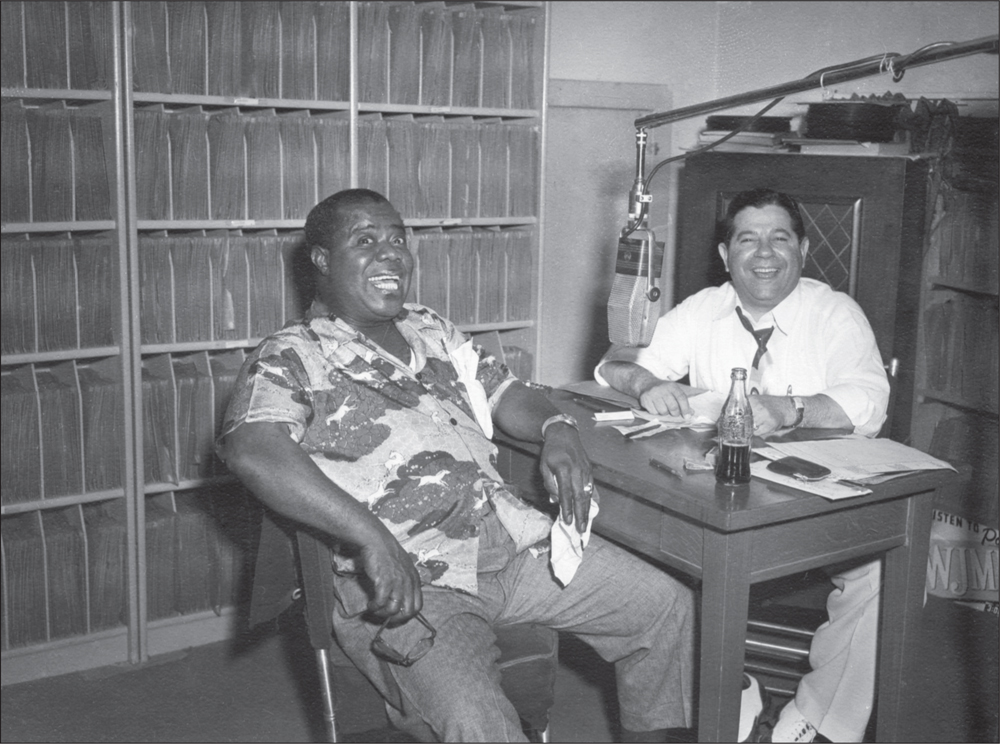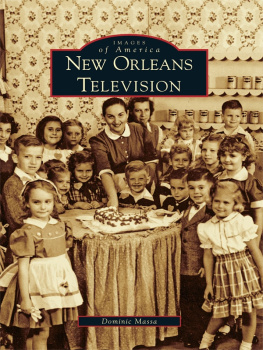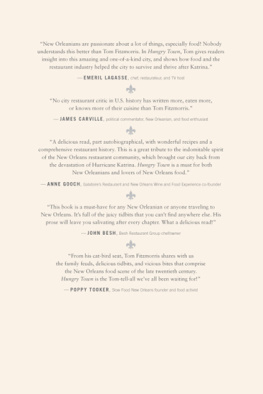Massa - New Orleans Radio
Here you can read online Massa - New Orleans Radio full text of the book (entire story) in english for free. Download pdf and epub, get meaning, cover and reviews about this ebook. City: Louisiana;New Orleans;New Orleans (La, year: 2014, publisher: Arcadia Publishing Inc., genre: Non-fiction. Description of the work, (preface) as well as reviews are available. Best literature library LitArk.com created for fans of good reading and offers a wide selection of genres:
Romance novel
Science fiction
Adventure
Detective
Science
History
Home and family
Prose
Art
Politics
Computer
Non-fiction
Religion
Business
Children
Humor
Choose a favorite category and find really read worthwhile books. Enjoy immersion in the world of imagination, feel the emotions of the characters or learn something new for yourself, make an fascinating discovery.

- Book:New Orleans Radio
- Author:
- Publisher:Arcadia Publishing Inc.
- Genre:
- Year:2014
- City:Louisiana;New Orleans;New Orleans (La
- Rating:5 / 5
- Favourites:Add to favourites
- Your mark:
- 100
- 1
- 2
- 3
- 4
- 5
New Orleans Radio: summary, description and annotation
We offer to read an annotation, description, summary or preface (depends on what the author of the book "New Orleans Radio" wrote himself). If you haven't found the necessary information about the book — write in the comments, we will try to find it.
New Orleans Radio — read online for free the complete book (whole text) full work
Below is the text of the book, divided by pages. System saving the place of the last page read, allows you to conveniently read the book "New Orleans Radio" online for free, without having to search again every time where you left off. Put a bookmark, and you can go to the page where you finished reading at any time.
Font size:
Interval:
Bookmark:

IMAGES
of America
NEW ORLEANS
RADIO

Louis Armstrong flashes his famous smile as fellow New Orleans trumpeter Tony Almerico interviews the music icon for a 1952 episode of Almericos weekly music show on WJMR-AM. In addition to his hosting duties there, Almerico and his band performed on WWLs Dixieland Jamboree session, which was taped at the Parisian Room on Royal Street and broadcast each week nationwide. (Courtesy of the New Orleans Jazz Club Collection of the Louisiana State Museum.)
ON THE COVER: With a smile, a laugh, and a song, members of WWLs famed Dawnbusters troupe, including Margie ODair (left), Pinky Vidacovich (center), and Henry Dupre at the microphone, take to the air for their beloved morning program, which ran from 1937 until 1959. (Courtesy of the Loyola University J. Edgar and Louise S. Monroe Library.)
IMAGES
of America
NEW ORLEANS
RADIO
Dominic Massa

Copyright 2014 by Dominic Massa
ISBN 978-1-4671-1242-0
Ebook ISBN 9781439647905
Published by Arcadia Publishing
Charleston, South Carolina
Library of Congress Control Number: 2014932465
For all general information, please contact Arcadia Publishing:
Telephone 843-853-2070
Fax 843-853-0044
E-mail
For customer service and orders:
Toll-Free 1-888-313-2665
Visit us on the Internet at www.arcadiapublishing.com

WNOE star Bill Elliott was a radio veteran of 15 years when he joined the station in the mid-1940s. Possessing a deep bass voice, acquired through years of experience, Bill Elliott is a fairly versatile fellow, wrote The Illustrated Press in 1948. The publication called him a stellar disc jockey, interviewer, and crack special events man. (Courtesy of The Historic New Orleans Collection, Gift of Mrs. Barbara B. Wedemeyer, Acc. No. 2007.0062.)
CONTENTS
ACKNOWLEDGMENTS
As a television producer and someone with a deep appreciation for broadcasting history, I have often heard the story of what many television pioneers were told when they were first approached about using the new medium: It is just radio with pictures. This book is just that: radio with pictures. Thanks to those who have helped me try to tell the story.
At the top of the list is Bob Murret, whose passion for New Orleans, its music, and its radio history is nearly unparalleled. Rare on the Air, as he is known on WWOZ, opened up his own collection to me while also helping to identify key contacts.
Bob Walker, the Oldie King, was equally generous with his time, contacts, and, most of all, material. His Facebook pages and website, www.neworleansradioshrine.com, are valuable and fun archives.
Tika Laudun of Louisiana Public Broadcasting, who produced the 2005 documentary Making Waves: Louisianas Radio Story, helped with archival photographs.
In addition to the many people thanked for photographs inside these pages, appreciation goes to Don Cooper, Bob Dunn, Gary Pfeifer, Matt Dillon, Cathy Jacob Gaffney, Alex Bowab, Carl Mann, Paul Beaulieu, and Rev. Skip Alexander.
Special thanks to the staff at these institutions: Joan Gaulene at Loyola University; Mary Lou Eichhorn and Daniel Hammer at The Historic New Orleans Collection; Irene Wainwright, Wayne Everard, and Greg Osborn at the New Orleans Public Library; Greg Lambousy and Anna Gospodinovich at the Louisiana State Museum; and Susan Tucker at Tulanes Newcomb Archives and Vorhoff Library.
At Arcadia Publishing, I am grateful to Maggie Bullwinkel and Lydia Rollins for their guidance.
At WWL-TV, thanks go to Tod Smith and Bill Siegel for their ongoing support. Thanks also to dear friends at WYES-TVBeth Arroyo Utterback, Peggy Scott and Errol Laborde, and Larry Roussariewho lend encouragement and help in all sorts of ways.
Lastly, thanks to my family, in particular my parents, Diane and Joe Massa, who have always encouraged my interest in history and given me the love and support needed to launch the next new project.
INTRODUCTION
Guglielmo Marconis invention may be well over 125 years old, but radio remains one of the worlds most transient businesses. In radio broadcasting, announcers come and go, disc jockeys and talk-show hosts are easily replaced, formats change, and stations are sold. So how is it that some of the best-known names in New Orleans radioHenry Dupre, Pinky Vidacovich, Vernon Winslow, Jill Jackson, Clarence Hamann, Larry McKinley, Robert Mitchell, and Bob Walker, to name but a fewbelong to people who spent several decades firmly anchored in this town and became beloved personalities? As Louis Armstrong once said when asked to define jazz, if you have to ask, you will never know.
New Orleans is a city like few others, so it stands to reason that, while its radio history in some ways mirrors that of other cities, it also has its own flair. The city played a pivotal role in many aspects of American broadcasting history, having given birth to the first radio station in the lower Mississippi River Valley, WWL, which signed on the air in 1922, the outgrowth of physics experiments and wireless radio classes at Loyola University. The early years were experimental, innovative and mostly formless, as one writer explained in a history of WWLs early years. It was only through the interest and dedication of Jesuit priests, professors, and students that WWL grew from its early, humble beginnings into a national treasure.
WDSU, which became a broadcasting powerhouse when it introduced the citys first television station, followed WWL with its own radio station, though it would take several more years to develop. By 1925, the city had its first commercial station, WSMB, which, unlike the six other radio stations on the air by that time, was designed as the first self-supporting broadcast business. Its facilities on the 13th floor of the Maison Blanche Building on Canal Street were top-of-the-line, so much so that when station legends Nut and Jeff were broadcasting more than 50 years later at the height of their fame in the 1970s, they were sitting in those very same studios.
Nut and Jeff, in real life Roy Roberts and Jeff Hug, were two of the local radio personalities who became icons by simply doing what they did besttalking and being New Orleanians. The same goes for WSMB night owl Larry Regan and midday talker Keith Rush, who both became enormously popular on WSMB just by talking the talk before there was a talk radio format to emulate. On WWL, Irvine Pinky Vidacovich knew his Dawnbusters audience and the Louisiana spirit so well that he wrote more than 30 songs employing Cajun themes and dialect. His music and his comedy (more than 4,000 skits, by one estimate) were popular locally and nationally. WWLs Blue Room supper club broadcasts from the Roosevelt Hotel (and, later, Charlie Douglass Road Gang trucker shows) were carried by the stations 50,000-watt, clear-channel signal to listeners worldwide.
By the late 1940s, musical styles and sounds were changing, and New Orleans radio stations and broadcasters were part of that change. Despite the reality of segregation, which delayed his own on-air debut, Vernon Doctor Daddy-O Winslow, as the citys first African American disc jockey, was encouraging change by playing the music that inspired a New Orleans rhythm and coaching a generation of broadcasters who played a key part in developing the early rhythm and blues sounds that became rock n roll. Without Dr. Daddy-O, there would be no Okey Dokey Smith, no Jack the Cat Elliott, and certainly no Poppa Stoppa, the most famous and imitated of them all: Clarence Hamann.
Next pageFont size:
Interval:
Bookmark:
Similar books «New Orleans Radio»
Look at similar books to New Orleans Radio. We have selected literature similar in name and meaning in the hope of providing readers with more options to find new, interesting, not yet read works.
Discussion, reviews of the book New Orleans Radio and just readers' own opinions. Leave your comments, write what you think about the work, its meaning or the main characters. Specify what exactly you liked and what you didn't like, and why you think so.








